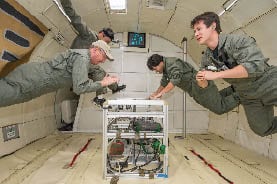Latest News
At SATELLITE 2013, feeding the talent pipeline for the next generation of aerospace engineers interested in satellites, launch vehicles, spacecraft management, earth station technology, and all that goes with it, was noted repeatedly.
NASA’s Reduced Gravity Education Flight Program propels interest in aerospace engineering careers by staging a regular competition in microgravity studies – one that offers the chance to fly a student experiment in a controlled zero-gravity environment. In July I joined about 60 undergrads comprising seven or eight teams as the “journalist mentor” of the Purdue University contingent, along with mentors and teams from the University of California San Diego, West Virginia University, and other colleges.

Research team from Purdue University with their original experiment investigating condensed water management in fuel cell gas passages. Clockwise from front left SATELLITE 2014 chairman Scott Chase and students Chris Yamamoto, Sagar Thapa, and Joshua Wolf. Photo courtesy of NASA.
Nearly a year before, the Purdue team had submitted a winning experiment proposal titled “Water Removal in Proton Exchange Membrane Fuel Cells,” aimed at “advancing water management designs of PEM cells for both ground- and space-based applications.” I was delighted to learn via a web entry that PEMFCs are “a leading candidate to replace the aging alkaline fuel cell technology which was used in the Space Shuttle.”
The six Purdue students on my team devoted countless hours to their experiment across their junior and senior years under the expert guidance of Dr. Steven Collicott, a professor of Aeronautics and Astronautics at Purdue since 1991. The zeal of these young people was palpable as they toiled over adjustments and tests and retests, all in the very warm confines of NASA Hangar 990, Johnson Space Center.
All envision careers somewhere in the stream of opportunities embraced by aeronautical engineering: Two plan to continue into graduate studies, one is working part-time for a launch services provider, and all would consider being astronauts.
NASA’s Reduced Gravity Education Flight Program has flown nearly 5,000 students and educators over the past several years. I took my first zero-g flight with Purdue back in February 2001. Like then, my 2013 team divided up into two groups, and each group had a chance to fly in the specially modified 727 operated by Zero-G Corporation. The flight profile includes 30 zero-g parabolas, offering up to 15 minutes of weightlessness in increments of 25 to 30 seconds. This typically is enough time to test the experiments, log results, and then test again.
On our first flight there was a glitch in some aspects of data acquisition. Test results were captured, but the in-flight video did not engage. Not to be daunted, the team assessed what went wrong, made critical platform changes that afternoon, and was ready early the next day for a revalidation mission.
Dawn broke partly cloudy over the Gulf of Mexico that Sunday morning as we boarded the Zero-G 727. Soon thereafter, we got the all-clear to unbuckle and prep the experiment. Having spent the previous 10 days getting ready at Johnson Space Center, we were ready to maximize our short time in zero-g. Within the first 15 loops, my guys could tell me with satisfaction that they had the data – and the video – to complete their analysis and produce usable results.
While I doubt that I ever really will need to know much more about PEMFCs, one way or another I’m sure to cross paths in the world’s satellite-enabled marketplace with at least some of the thousands of student superstars who have flown zero-g and chosen aeronautical engineering as their own personal paths to the future.
Thanks to NASA’s commitment, filling the pipeline for future engineers and aerospace talent is, in this case, just a matter of gravity.
Get the latest Via Satellite news!
Subscribe Now